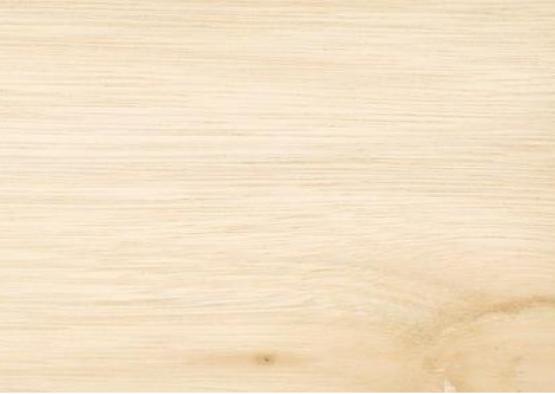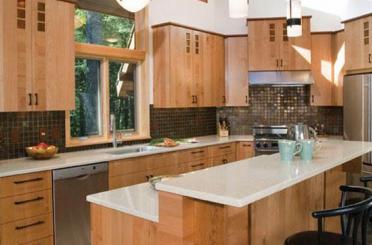Shining gum is a native Australian hardwood gaining popularity for its versatility, interesting colour and speckled appearance.

The native hardwood, shining gum, produces timber used predominantly in construction and furniture making. As a plantation managed timber subject to advanced silvicultural and milling methods, shining gum is gaining in popularity.
Shining gum is prevalent in the mountain areas of east Gippsland and south-eastern NSW as well as the northern tablelands of NSW to an altitude of 1600m. It is a popular plantation timber as it can be extremely quick growing. Eucalyptus nitens is grown as a commercial plantation species in cool temperate regions around the world, including Tasmania, New Zealand, South Africa and Chile.
Shining gum trees can reach heights of 70m, and diameters of 1-2m at chest height. Its form is desirable, with a straight bole up to two-thirds the height of the tree. Its smooth white or greyish bark is shed in long ribbons. It gets its name nitens (meaning shining) from the distinct glossy fruits, which have a varnished appearance, as well as the leaves, buds and bark, which can also appear to shine. The juvenile leaves have a pleasant fruity smell.
Shining gum timber exhibits some interesting colours making it an appealing product for furniture making. The wood is pale pink and straight grained. It is suitable for general building, flooring, joinery, paneling, furniture and framing. It is also considered a good quality pulping species, although not as high yielding as some due to its lower density.
Shining gum is not particularly durable (class 4) and is not recommended for external use, especially not in-ground. It is vulnerable to termites and the sapwood is susceptible to Lyctid borer.
Shrinkage
| Very Low | Low | Medium | High | Very High | |
|---|---|---|---|---|---|

|

|
||||
Tangential : |
9.40%
|
||||
Radial : |
4.90%
|
||||
Unit Movement Tangential: |
0.33%
|
||||
Unit Movement Radial: |
0.22%
|
Strength Group

Very High |
High |
Reasonably High |
Medium High |
Medium |
Reasonably Low |
Low |
Very Low |
||
Unseasoned: |
S1 |
S2 |
S3 |
S4 |
S5 |
S6 |
S7 |
S8 |
|
|---|---|---|---|---|---|---|---|---|---|
 |
|||||||||
Seasoned: |
SD1 |
SD2 |
SD3 |
SD4 |
SD5 |
SD6 |
SD7 |
SD8 |
|
 |
Stress Grade

| Structural No. 1 |
Structural No. 2 |
Structural No. 3 |
Structural No. 4 |
Structural No. 5 |
|
Unseasoned: |
F14 |
F11 |
F8 |
F7 |
F5 |
Seasoned: |
F22 |
F17 |
F14 |
F11 |
F8 |
Density per Standard

Seasoned: |
680kg/m3
|
|---|---|
Unseasoned: |
1120kg/m3
|
Joint Group

Very High |
High |
Reasonably High |
Medium |
Low |
Very Low |
|
Unseasoned: |
J1 |
J2 |
J3 |
J4 |
J5 |
J6 |
|---|---|---|---|---|---|---|
 |
||||||
Seasoned: |
JD1 |
JD2 |
JD3 |
JD4 |
JD5 |
JD6 |
 |
Colour

| White, yellow, pale straw to light brown | Pink to pink brown | Light to dark red | Brown, chocolate, mottled or streaky | |
 |
||||
Mechanical Properties
Modulus of Rupture - Unseasoned: |
62
|
|---|---|
Modulus of Rupture - Seasoned: |
99
|
Modulus of Elasticity - Unseasoned: |
10
|
Modulus of Elasticity - Seasoned: |
13
|
Maximum Crushing Strength - Unseasoned:  |
31
|
Maximum Crushing Strength - Seasoned: |
58
|
Impact - Unseasoned: |
15
|
Impact - Seasoned: |
16
|
Toughness - Unseasoned: |
Medium - 15 - 24 Nm
|
Toughness - Seasoned: |
Medium - 15 - 24 Nm
|
Hardness - Unseasoned: |
4.8
|
Hardness - Seasoned: |
5.8
|
Durability
| Low | Moderate | Reasonably High | High | |
| (0 - 5 yrs) | (5 - 15 yrs) | (15 - 25 yrs) | (more than 25 yrs) | |
In-Ground: |
 |
|||
| (0 - 7 yrs) | (7 - 15 yrs) | (15 - 40 yrs) | (More than 40 yrs) | |
Above ground: |
 |
|||
| (0 - 20 yrs, usually < 5) | (21 - 40 yrs) | (41 - 64 yrs) | (More than 60 yrs) | |
Marine Borer Resistance: |
 |
Lyctid Borer Susceptibility: |
Susceptible |
|---|---|
Lyctid Borer Susceptibility - Other: |
|
Termite Resistance: |
Not Resistant
|
Fire Properties
| 0 | 1 | 2 | 3 | 4 | 5 | 6 | 7 | 8 | 9 | 10 | |
EFH Spread-of-Flame Index: |
|||||||||||
EFH Smoke-Developed Index: |
Critical Radiance Flux - Lower: |
>2.2 and <4.5 |
|---|---|
Critical Radiance Flux - Higher: |
>2.2 and <4.5 |
Smoke Development Rate: |
<750
|
| 1 - non-combustible | 2 - reasonably non-combustible | 3 - slightly combustible | 4 - combustible | |
Fire Properties Group |
Average Specific Extinction Area: |
<250
|
|---|---|
Bushfire Resistance: |
BAL 12.5 and 19 – Door and window joinery only
|
The timber of shining gum, as its name implies, has lustrous qualities. The heartwood is a straw colour bursting with pink and yellow tints. The sapwood is not always easy to distinguish from the heartwood. The texture of shining gum timber is moderately coarse with a straight grain.
Shining gum is not self-pruning. Branch retention creates a high incidence of features in milled timber for that reason. Pin-hole borer holes and the associated black stains of 'pencil streak' are often present, giving timber a speckled appearance. Growth rings are also a prominent feature of this timber.
Timber from shining gum has a wide range of uses, from pulp to sawn products. It is a good quality pulping species, although the wood is of slightly lower density than Tasmanian blue gum and therefore gives lower pulp yields. When plantation grown, it has the potential to produce sawlogs of select grade material if pruned. The timber is used for general construction: joinery, framing and flooring. The pale wood of young trees means the timber can be interchanged with mountain ash. It is also beginning to be used for furniture, where its discolouration is seen as a feature.
The general workability of shining gum timber is good, as it is not an extremely dense or hard timber. The green density of the timber is 1050 kg/m3 and air-dry density at 12% moisture is about 700 kg/m3.
Shining gum is difficult to dry with moderate shrinkage and a high cell collapse necessitating reconditioning. It is prone to surface checking and requires careful drying and storage because of collapse.
The wood is not as hard as blue gum, being moderately hard at 5.8 kN when dry. The heartwood of shining gum is not sufficiently durable for external use (class 4).
Allied Forest Products

Cusp

Mathews Timber Pty Ltd

Matilda Veneer

Outlast Timber Supplies

Pentarch Forestry

Ridgewood Timber Pty Ltd

Ta Ann Tasmania Pty Ltd

Three(3)DM Pty Ltd

Timber Blitz Pty Ltd

Timber Revival






